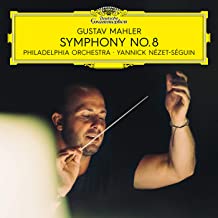
Now that social contact is mostly limited to familiar faces on computer screens, Mahler’s Symphony No. 8 (“Symphony of a Thousand”) truly feels like something from an alternate world, if only because of the size of the performing forces.
Chorus upon chorus plus eight top-caliber soloists are out to convey the ever more esoteric seven circles of heaven in a work that starts with a huge re-imagining of the hymn “Veni Creator Spiritus” and ends with all manner of angels and ascended masters in the final scene of Goethe’s Faust. Even though the piece can be credibly done with a mere 300 singers and instrumentalists, it’s not often performed, and it’s sometimes discussed as the summit of Mahler, with the success of recordings resting as much with the sound engineers as with the performing forces.
Yannick Nézet-Séguin’s arrangement with Deutsche Grammophon is such that all of his Philadelphia concerts have a special DG-approved microphone placement, making anything he conducts, in theory, a candidate for larger release. But with a time lag. This Mahler 8th arrives some four years after the live performances, and it signals not only a high-water mark in Nézet-Séguin’s relationship with the orchestra but a certain evolution in the performance practice of the piece itself. Neither a symphony nor an opera, the Symphony No. 8 is its own genre. And where it lands on the symphony-versus-opera spectrum changes with each performance.
Like James Levine before him, Nézet-Séguin gives the score an operatic manner, not necessarily because the two have leadership of the Metropolitan Opera in common but because Nézet-Séguin simply has the energy level that prompts a full-blooded, full-bodied interpretation. Anyone allergic to operatic vibratos might be taken aback by Part One, which sounds like many hundreds of tonsils coming at you through the speakers. No, this isn’t the kind of power-in-reserve performance you got from the late Robert Shaw: all reserves of power are used — thrillingly — stopping just short of blasting.
Then comes Part Two, the Faust section, beginning with a long orchestral prelude allowing a certain amount of vocal rest. As much as the movement feels like opera, it’s far from it. The music has dramatic thrust, and the individual vocal soloists have character names, but they’re basically there to expound on the heavenly realms they inhabit.
Mahler 8th skeptics say that the pairing of the symphony’s two parts is a shotgun wedding, done in the composer’s effort to write a successful potboiler in keeping with the early-20th-century fashion for musical gargantuanism. This performance, however, reflects a resourceful wisdom you don’t expect from this still-youthful conductor (especially if you heard Nézet-Séguin’s 2010 Mahler 8th in Ottawa). The score’s thematic elements are writ so large in Part One that their metamorphosis in the intelligently-conceived Part Two is all the more evident — and made clear by the conductor in one moment after another.
In other repertoire, Nézet-Séguin is the great consolidator, the master negotiator between disparate musical elements that don’t seem to belong together but become connected by a kind of logic that can be so subtle you wonder if the composers consciously intended it. Nézet-Séguin finds that logic, but never at the expense of a coherent progression of the various events within a piece.
I’ve long struggled with the Goethe text in Part Two of the 8th, wondering how Mahler could get that kind of musical mileage out of words that seem so far removed from real life, with references to characters that can seem hopelessly obscure. In this recording, Nézet-Séguin helped me struggle less — because of the sense of thematic integration that carried my ear along with great confidence. So while the performance felt operatic on the surface, it had its own kind of symphonic structure underneath.
Yes, Mahler’s use of words here is hugely different from what is heard in his orchestral songs right up through Das Lied von der Erde. In the songs, pretty much every composing decision is an expression and reflection of the text. In Part Two of the Mahler 8th, the words are a springboard. One possible parallel is Renaissance polyphony, where the words are the initial germination point for a web of vocal architecture that outgrows any literal meaning, making the text an enshrined passenger to be contemplated and always thanked for — prompting contrapuntal miracles from the likes of Josquin Desprez. Given Mahler’s extreme literacy as a composer, I wouldn’t be surprised if he knew such works well.
The recording’s vocal lineup reflected Nézet-Séguin’s growing operatic clout circa 2016. Few orchestras could assemble a vocal lineup including Erin Wall, Elizabeth Bishop, Lisette Oropesa, Angela Meade, Mihoko Fujimura, Markus Werba, Anthony Dean Griffey and John Relyea. Among the choirs, you have the accuracy of the Westminster Symphonic Choir, the heftier adult voices of the Choral Arts Society of Washington and the ethereal American Boychoir. They all give big-concert-hall performances, exciting in their own ways. though I still prefer the Georg Solti recording on Decca, with choirs from Vienna, soloists mostly from England, and the orchestra from Chicago.
And the sound, the other crucial element in recordings of this enormous score? Well, engineering can almost always be better on the Mahler 8th.
But how this Philadelphia Mahler 8th stands in the larger discography can only be determined with the passage of time. With smaller-scale works, you often recognize a classic performance on first encounter. Not with this piece, which spent the early decades of its existence with musicians struggling just to get the notes, only to be neglected by some later 20th-century conductors who could’ve unlocked the music’s inner chambers more quickly. Imagine Mahler’s 8th Symphony as performed by Carlos Kleiber or Herbert von Karajan. Had those two taken it on, the way we hear the music would be quite different now.

